Black Mold in Your Toilet? Here's How to Safely Eradicate It
Author: Anne Cowart | Editor: Omar Alonso
Review & Research: Jen Worst & Chris Miller
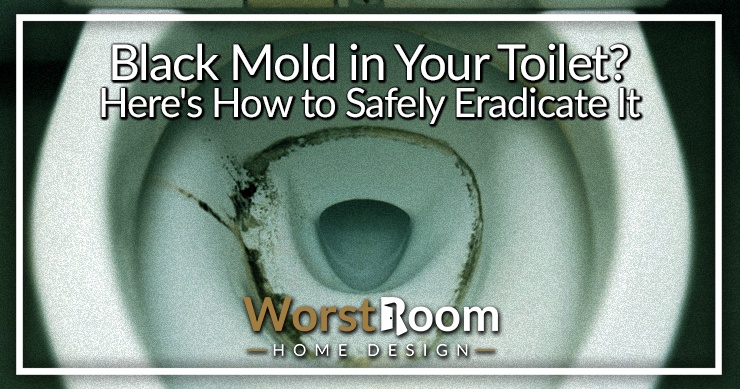
Black mold in your toilet is a common household issue that not only looks extremely unsightly but can also pose potential health risks. This pesky fungus thrives in the dark, humid environment of your toilet bowl and tank, leaving an unpleasant ring around the inner bowl.
Generally, the mold also includes a build-up of other minerals and mildew – thankfully, it is unlikely to be the “toxic” black mold species, known as Stachybotrys chartarum.
In this article, we’ll discover the potential root causes behind black mold growth in toilets, learn how to effectively remove it using natural remedies or cleaning products, and find out tips on preventing its dreaded return.
What is the Black Mold in Your Toilet?
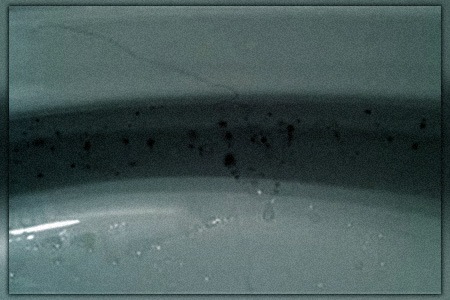
Before we get into how to effectively banish black mold from your bathroom, it might help to understand what this “black mold” really is.
It’s essentially discoloration that shows fungal and mildew growth. Although it may appear black, it can also be a dark moss green or a tinted orange-red.
Dampness in the bathroom can set the perfect conditions for mold growth. Spores are generally always in the environment in some capacity, but when they have the right amount of moisture, they can proliferate rapidly. Dark and warm environments, like the corners of the toilet bowl or behind the toilet are opportunistic spots for black mold formation.
How Does the Black Mold in Your Toilet Bowl Form?
What causes black mold in a toilet bowl? If you notice black mold in your toilet that indicates a build-up of fungi and mildew, you likely have noticed these spots in other areas of the bathroom. This can include bathroom shower caulking and directly behind the toilet on the wall adjacent to the bowl.
A couple of things can contribute to the excessive formation of black mold in a toilet bowl. Namely, moisture and darkness are a perfect recipe for mold formation.
Molds and mildews flourish best in dark, humid areas within the home. A bathroom is a perfect environment for mold spores, especially if there isn’t a lot of ventilation (ceiling exhaust fan, dehumidifier, windows).
A lot of older bathrooms weren’t constructed with mold prevention in mind, which means you may have to get creative with how to increase air circulation throughout the bathroom. We’d recommend opening windows if there are any, leaving the bathroom door open after a hot shower, and purchasing an economically sized dehumidifier just for that bathroom space.
Is Black Mold in Your Toilet Dangerous?
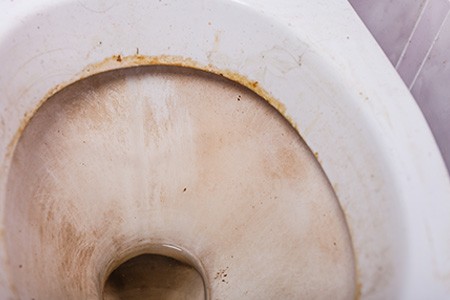
There are two problems with mold in your toilet bowl, even if you don’t notice it spreading to other areas of the bathroom.
One, despite not being the “deadly” toxic black mold that strikes panic into the hearts of homeowners, any type of fungus or mold can cause respiratory issues. Those susceptible to asthma or immune dysfunction should take extra precaution in cleaning the toilet or removing any preformed mold.
Two, while you might not notice the mold spreading from the toilet bowl to the rest of the bathroom yet, it doesn't mean it won’t happen. Any visible fungi and mold can increase the likelihood it’s slowly growing in other moist areas of the bathroom like the shower. More spores in the environment equal a greater chance of future mold.
If you have constant issues with a damp bathroom and don’t have proper ventilation, you’re much more likely to encounter progressive mold.
Black Mold in the Toilet Bowl
Black mold might frequently form in your toilet bowl (despite regular cleaning) due to the constant presence of water. Stillwater will accumulate fungi or mold spores, while the black “ring” commonly forms around the waterline or rim. These contact points where water meets the air help to promote mold formation.
Black Mold in the Toilet Tank
Is black mold hiding out in your toilet tank? The toilet tank is another common breeding ground for mold and mildew. Water constantly sits in the tank, while spores and mineral deposits settle on the walls of the interior of the tank. That's why you can see black stuff in the toilet tank after flushing.
It’s unlikely most homeowners or renters ever open and scrub the inside of the tank, so it easily becomes a habitual breeding ground for bacteria and mildew. Some people put Fabuloso in their toilet tank but doing so long term can have unexpected consequences, so please read about it before you attempt it.
Black Mold Behind the Toilet Tank
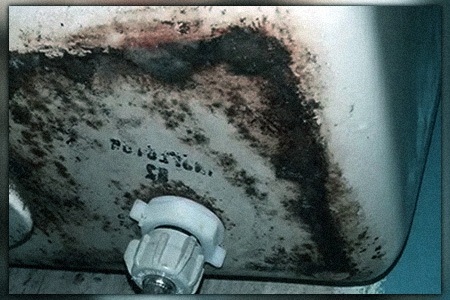
This last one is a little bit trickier, as it might indicate a leak at the base of the toilet. Fully functional toilets shouldn’t be leaking, and this can indicate a much larger problem that requires urgent attention. If you notice large pools of water sitting behind your toilet, you need to contact a plumber immediately.
However, if you only notice a bit of mildew or mold built up on the wall behind the toilet tank, or on the outer surface of the tank, this is more likely to be from excess moisture.
How to Get Rid of Black Mold in Your Toilet
Preventing black mold from growing in your toilet is easier than dealing with it after it has already formed. Regular cleaning, proper ventilation, and controlling humidity levels are some of the many ways you can prevent mold or mildew from forming.
However, the same steps apply if you’re looking to clean up a mold problem that has already appeared – you might just have to be more rigorous and proactive.
Air Circulation & Dehumidifiers
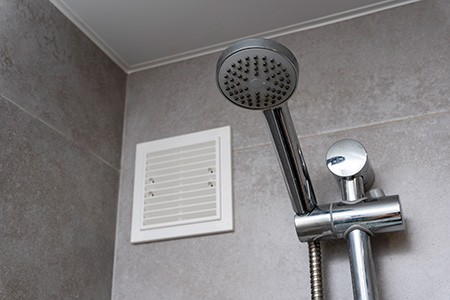
Keeping your bathroom well-ventilated after showering or bathing is the primary way to prevent moisture buildup that can lead to mold growth in your toilet and bathroom.
Proper ventilation means turning on an exhaust fan or opening windows for at least half an hour after using the shower. This will allow steady air circulation that helps reduce humidity levels in your bathroom, ultimately helping prevent spore growth.
If you have poor ventilation in your bathroom, which is common in older homes, we’d recommend purchasing a cheap and economic dehumidifier just for the bathroom space. There are some disadvantages to a dehumidifier but they don't outweigh the positives here.
Wear Protective Gear
Protecting yourself is essential when cleaning black mold in your toilet. The first step is to ensure you wear proper gloves, a mask, and eye protection when removing the fungus as it produces spores that might be harmful if inhaled.
You may want to prevent breathing in spores by wearing an N95 mask while handling any mold if you have asthma or an autoimmune condition. Similarly, wearing a pair of rubber gloves will help protect your hands from harsh cleaners like bleach.
Remember to always wash your equipment after use with hot water and detergent solution before stowing them away for future use if you’re dealing with mold, fungus, or mildew.
Natural Cleaning Solutions
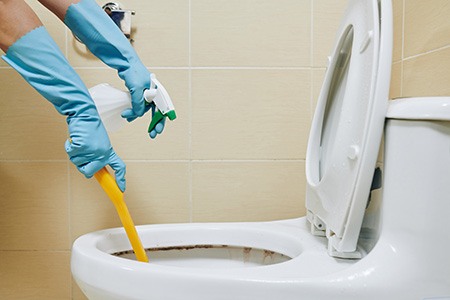
To effectively remove black mold in a toilet, using cleaning products is an obvious necessity.
There are various cleaning solutions available, some formulated specifically for dealing with toilet bowl mold and bathroom mildew. Other “household” cleaners include bleach, hydrogen peroxide, and dish detergent. They can all deal with black sediment in the toilet bowl.
It’s essential to read instructions carefully before use and ensure they're safe for your toilet and septic system. Be sure only to use cleaning products that are safe for your toilet material (i.e., porcelain).
For a more natural solution, white vinegar can be used just as effectively. Some brands even offer a stronger concentration of acetic acid, specifically for home cleaning.
Pour the white vinegar into the bowl overnight or add to a spray bottle to apply directly onto affected areas. Baking soda can also be effective when sprinkled in the bowl and left to sit overnight. After a minimum of 30 minutes, baking soda can be scrubbed with a bristle brush.
Don’t just clean under the rim, but also target all the surrounding areas including the tank, base, lid, and seat.
If you need to clean the inside of the toilet tank, you’ll need to ensure you close the shutoff valve first (knob behind the toilet) – give it a clockwise twist until it halts water flow. After you remove the lid with your hands, you can pour distilled vinegar inside the tank, but not baking soda. While many people opt for bleach, white vinegar is our preferred cleaner.
The vinegar should be left to soak the tank for at least 20-30 minutes, but the walls can be gently scrubbed with a rag or cloth in the meantime. Once fully clean and scrubbed down, take a bucket of water and use it to flush out the tank.
After removing the mold, you can put the tank lid back and open back up the shutoff valve.
Preventing Black Mold in Your Toilet From Returning
Preventative measures are better than struggling to find a solution once the problem has already appeared. While it might not be “toxic,” toilet mold can still be harmful if the spores release into the air and are inhaled – which is likely every time you flush the toilet. It can be especially problematic for those with allergies, asthma, and autoimmune conditions.
While these health issues rarely occur as a result of common toilet mold, if left unaddressed, the black mold in your toilet can encourage further growth across other moist spots in your bathroom. No homeowner or renter wants to see grimy black mold in their toilet after flushing. While both mildew and mold can grow rapidly, they can also be easily prevented.




